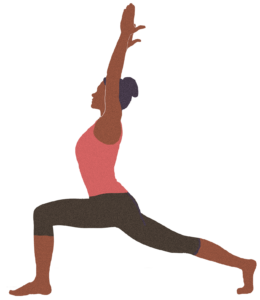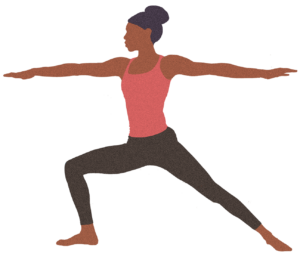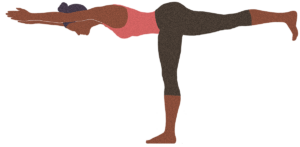These poses open the hips, strengthen and stretch the legs, ankles, and core, and improve balance and posture.
The Virabhadrasana poses, also known as the Warrior poses, first emerged in the early 20th century and are credited to the famous Indian yoga teacher Krishnamacharya (“the father of modern yoga”). The poses were later popularized in the late 1970s by Krishnamacharya’s students Devi, Jois, and Iyengar.1
The origin of the Warrior poses is derived from the mythological story of Shiva, a Hindu deity.2 According to the story, Shiva was married to Sati, daughter of Daksha, a worldly creator in Hindu. Daksha, believing Shiva to be beneath Sati, did not approve of his daughter’s marriage, and as punishment did not invite the couple to a great party attended by all the members of the heavenly universe. Upset by this, and leaving Shiva at home, Sati showed up at the party with the hope of convincing Daksha of Shiva’s worth. Instead, Daksha publicly humiliated her by making derogatory remarks about Shiva and laughing at her attempts to defend him. Saddened and indignant by her father’s behavior, Sati vowed, “Since you have given me this body I no longer wish to be associated with it,” and threw herself into a great fire (var. or burst into flame) and died. Enraged by Sati’s death, Shiva pulled out a chunk of his hair and from it fashioned a fierce warrior he named Virabhadra. He ordered Virabhadra to kill Daksha. Virabhadra arrived at the party by thrusting his way up through the earth with his sword clasped in both hands (represented by Warrior I pose). Upon his arrival, Virabhadra sited his opponent, Daksha (represented by Warrior II pose), and with precision and speed, cut off Daksha’s head with his sword (represented by Warrior III). After reabsorbing Virabhadra back into his body, Shiva was saddened and remorseful over the destruction he caused. In an act of contrition, he found the headless body of Daksha and brought him back to life with the head of a goat. A thankful and now humbled Daksha was overwhelmed by Shiva’s generosity and kindness, and thereafter honored Shiva as a kind and benevolent deity, and the other deities soon followed in kind.2
Virabhadrasana poses are said “symbolize our inner ability to overcome ego and ignorance. The Warriors challenge and test us but in doing so bring us strength, focus, confidence and courage.”3
 Warrior I
Warrior I
1. Stand straight with your legs wide apart.
2. Turn right foot out at 90 degrees and the left foot in slightly.
3. Align the left heel to the center of the other foot.
4. Place your hands on your hips and turn your shoulders, chest, and pelvis to the right.
5. Inhale and lift your arms from your sides to over your head with the palms of your hands pressed together.
6. Bring your shoulders down while keeping the left leg firm.
7. Exhale as you bend your right knee. Make sure to keep your right knee directly over the right ankle. The right thigh should be parallel to the ground. Do not let the right knee pass the ankle. The left leg should be straight.
8. Arch your back, drop your head back, and gaze upwards toward your hands or keep your head level and gaze straight ahead. Keep the outer edge of the right foot pressed firmly on the ground.
10. Engage your core and bring your tail bone in toward your pelvis. Hold for several breaths (10 to 20 seconds).
11. Inhale deeply and slowly straighten your right leg; then exhale and release your arms back down to your sides, stepping your feet together (Mountain pose).
12. Repeat on other side.
 Warrior II
Warrior II
1. Stand straight with your legs wide apart.
2. Turn right foot out at 90 degrees and the left foot in slightly.
2. Inhale as you stretch your arms straight out from your shoulders, parallel with the ground.
3. Exhale as you bend your right knee. Make sure to keep your right knee directly over the right ankle. The right thigh should be parallel to the ground. Do not let the right knee pass the ankle. The left leg should be straight.
4. Distribute your weight evenly between both legs. Press down through the outer edge of your back foot.
5. Keep the crown of your head over your pelvis and your shoulders over your hips.
6. Reach strongly through both arms front and back and turn your head to look past your right fingertips.
7. Hold for several breaths (10 to 20 seconds)
8. Inhale deeply and straighten your right leg; then exhale and release your arms, stepping your feet together.
9. Repeat on the other side.
 Warrior III
Warrior III
1. Begin in Warrior Pose 1 with your right foot forward.
2. Engage your core.
3. Pivot your left foot onto its toes so the left leg is in a neutral position.
4. On exhale, fold from the hips, lowering your torso until it is at about a 45 degree angle to the floor, with arms either straight out front (upper arms framing ears), following the same line as the torso, or in namasté (prayer position).
5. Inhaling, root down firmly through the right foot and begin to shift your weight forward. Start to lift the back foot from the floor.
6. Exhaling, straighten the right leg as you bring your body and left leg parallel with the floor, keeping core engaged and left leg, torso, head (facing floor,) and arms forming a straight horizontal line. Hold for several breaths (10 to 20) seconds.
7. Inhale deeply and slowly lift your torso back up while lowering your left leg.
8. On exhale, release your arms, stepping your feet together as you stand straight.
9. Repeat on other side.
Sources for Article
1. Burgin T. The 5 warrior poses of yoga. 11 Mar 2021. Yoga Basics website. https://www.yogabasics.com/connect/warrior-poses/. Accessed 17 Aug 2022.
2. The British Museum website. Virabhadra. https://www.britishmuseum.org/collection/term/BIOG15159. Accessed 16 Aug 2022.
3. Savage J. Why we practice the Warrior poses. Eckart Yoga website. https://www.ekhartyoga.com/articles/practice/why-we-practice-the-warrior-poses#:~:text=But%20this%20is%20Warrior%20Pose,%2C%20focus%2C%20confidence%20and%20courage. Accessed 17 Aug 2022
Sources for Warrior Poses
Arivalan K. Virabhadrasana: strengthen your arms, shoulders, thighs & back muscles. September 28, 2021 Femina website. https://www.femina.in/wellness/fitness/virabhadrasana-strengthen-your-arms-shoulders-thighs-back-muscles-206100.html
Savage J. Beginner tips for Warrior 3 pose. Eckart Yoga website. https://www.ekhartyoga.com/articles/practice/beginner-tips-for-warrior-3-pose
Yoga Journal site. Warrior 2 pose. https://www.yogajournal.com/poses/warrior-ii-pose/. Accessed 16. Aug 2022.
Written by
NHR Staff


 Warrior I
Warrior I Warrior II
Warrior II Warrior III
Warrior III

